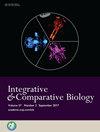Recent advances in the mechanistic understanding of avian responses to environmental challenges
IF 2.2
3区 生物学
Q1 ZOOLOGY
引用次数: 0
Abstract
Endothermic species have evolved strategies to maximize survival in highly variable or extreme environments. Birds are exemplary as they are among the most widely distributed endotherms on the planet, living in all manner of inhospitable environments. As an example, winter in temperate regions is characterized by cold temperatures and low food availability. Some birds have evolved to tolerate these conditions by seasonally increasing thermogenic capacity, increasing heterothermy, and displaying highly flexible phenotypes. Other species have evolved to avoid the inhospitable conditions of winter altogether by migrating—again requiring a unique set of physiological adaptations that allow success in this challenging endeavor. In these examples and in many others, the organismal requirements for success share similarities, but the underlying mechanisms, physiological requirements, and selection on those traits can differ significantly, as can their ecological and evolutionary impacts. In recent years, a suite of novel and established tools has become widely available and more accessible, allowing insights into long-standing questions. Genomic tools, new approaches to measure organismal performance, the use of citizen science data, easier access to metabolite assays or hormone detection, to name a few, have spurred rapid advances in our understanding of avian physiology. These new tools have been leveraged to investigate important questions regarding avian responses to our rapidly changing climate in an attempt to understand species resilience and limits.鸟类应对环境挑战的机理认识的最新进展
内温动物进化出了各种策略,以便在高度多变或极端的环境中最大限度地生存。鸟类就是一个例子,因为它们是地球上分布最广的内温动物之一,生活在各种恶劣的环境中。例如,温带地区冬季的特点是气温低、食物少。一些鸟类在进化过程中通过季节性提高产热能力、增加异温性和表现出高度灵活的表型来忍受这些条件。另一些物种则通过迁徙进化来完全避免冬季的恶劣条件--这同样需要一套独特的生理适应能力,才能成功完成这项具有挑战性的工作。在这些例子和其他许多例子中,成功对生物体的要求有相似之处,但其潜在机制、生理要求和对这些特征的选择可能有很大不同,它们对生态和进化的影响也有很大不同。近年来,一系列新颖和成熟的工具已被广泛使用,而且更容易获得,从而使人们能够深入了解长期存在的问题。基因组工具、测量生物体能的新方法、公民科学数据的使用、代谢物测定或激素检测的更易获取性等等,都促使我们对鸟类生理学的了解取得了飞速的进步。我们利用这些新工具来研究有关鸟类对快速变化的气候的反应的重要问题,试图了解物种的恢复能力和极限。
本文章由计算机程序翻译,如有差异,请以英文原文为准。
求助全文
约1分钟内获得全文
求助全文
来源期刊
CiteScore
4.70
自引率
7.70%
发文量
150
审稿时长
6-12 weeks
期刊介绍:
Integrative and Comparative Biology ( ICB ), formerly American Zoologist , is one of the most highly respected and cited journals in the field of biology. The journal''s primary focus is to integrate the varying disciplines in this broad field, while maintaining the highest scientific quality. ICB''s peer-reviewed symposia provide first class syntheses of the top research in a field. ICB also publishes book reviews, reports, and special bulletins.

 求助内容:
求助内容: 应助结果提醒方式:
应助结果提醒方式:


